




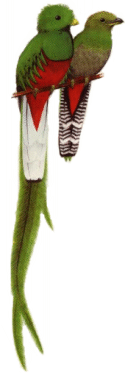
|

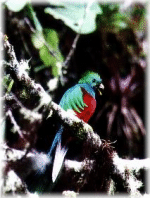 The Quetzal (Pharomachrus mocinno) is the bird the Aztecs
adored, and it is considered one of the most beautiful birds in the tropics.
It is down here, in Mirador de Quetzales, where you can admire the
Quetzal at its best! Come and enjoy with us the warmth of our lodge,
sorrounded by Cloud Tropical Forest and clear water creeks flowing down
the mountains.
The Quetzal (Pharomachrus mocinno) is the bird the Aztecs
adored, and it is considered one of the most beautiful birds in the tropics.
It is down here, in Mirador de Quetzales, where you can admire the
Quetzal at its best! Come and enjoy with us the warmth of our lodge,
sorrounded by Cloud Tropical Forest and clear water creeks flowing down
the mountains.
We offer 8 cabins and 4 rooms in the main lodge, as well as a rustic mountain
restaurant where we prepare for you delicious Costa Rican dishes.
Due to its location, Mirador de Quetzales is very easy to reach by car or by bus,
and we are always happy to provide you with all the information you need in order to get here, as well as
bus schedules or car rental reservations.
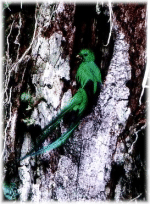 RESPLENDENT QUETZAL
((Pharomachrus mocinno)
RESPLENDENT QUETZAL
((Pharomachrus mocinno)
Description: 14" (36 cm), plus up to 25" (64 cm) for male´s streamers; 210 g. Male
unmistakable even without streamers because of literally compressed, helmetlike crest that extends forwars to cover base of bill; female and young crestless but with distinctively barred tail, gray breast.
Adult male: mostly glittering green; elongated wing-coverts extend to sides of breast.; 4 central upper tail-covertselongated into slender, flexible streamers; remiges and central rectrices black; lateral rectrices white; lower breast maroon; shading to bright crimson on belly. Bill yellow; feet olive-gray.
Adult female: much duller; wing and tail-coverts only slightly elongated; head dull bronze-green; breast gray; belly paler crimson; lateral rectrices coarsely barred with black and white; upper mandible black.
Inmatures: like adult female but above more bronzy; tail more coarsely barred.
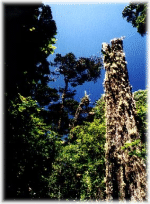 Young: above dark sooty-brown; scapulars, wing-coverts, and tertials with extensive buffy bases and edges; below buff, fading to white on belly, indistinctly barred or smudged with dusky.
Habits: Prefers damp, epiphyte-laden mountain forests, frequenting canopy and edges, usually solitary or in pairs, though several may gather at a fruiting tree; may travel in small loose flocks following breeding; sallies to pluck fruits or snatch insects, small frogs and lizards or snails, favorite fruits include various Lauraceae, also Symplocos.
Voice: Most often heard is a sharp, cackling perwicka, upon taking flight or in agitation; male´s song of deep, smooth, slurret notes in simple patterns: keow kowee keow k´loo keow k´loo keeloo ..., often strikingly melodious; also whining notes, chiefly in nesting season; in steeply rising display flight, male calls very good, very good.
Nest: A deep, woodpeckerlike, unlined cavity with a single entrance, 14 - 90 ft (4.3 - 27 m) up in decaying trunk in forest or nearby clearing. Eggs 2, pale blue. March - June (often 2 broods).
Status: Fairly common resident of forested or partly forested mountains from Cordillera de Tilarán S to Panamá; upward from 4,000 ft (1,200 m) in Cordillera de Tilarán, and from 5,000 ft (1,500 m) to over 10,000 ft (3,000 m) in Cordilleras Central and of Talamanca; following breeding makes limited altitudinal movements; persists in largely deforested areas if remnant woods contain good feeding and nesting trees.
Range: Southern Mexico to Western Panamá. Note: Pronounced Ket-saal'
Young: above dark sooty-brown; scapulars, wing-coverts, and tertials with extensive buffy bases and edges; below buff, fading to white on belly, indistinctly barred or smudged with dusky.
Habits: Prefers damp, epiphyte-laden mountain forests, frequenting canopy and edges, usually solitary or in pairs, though several may gather at a fruiting tree; may travel in small loose flocks following breeding; sallies to pluck fruits or snatch insects, small frogs and lizards or snails, favorite fruits include various Lauraceae, also Symplocos.
Voice: Most often heard is a sharp, cackling perwicka, upon taking flight or in agitation; male´s song of deep, smooth, slurret notes in simple patterns: keow kowee keow k´loo keow k´loo keeloo ..., often strikingly melodious; also whining notes, chiefly in nesting season; in steeply rising display flight, male calls very good, very good.
Nest: A deep, woodpeckerlike, unlined cavity with a single entrance, 14 - 90 ft (4.3 - 27 m) up in decaying trunk in forest or nearby clearing. Eggs 2, pale blue. March - June (often 2 broods).
Status: Fairly common resident of forested or partly forested mountains from Cordillera de Tilarán S to Panamá; upward from 4,000 ft (1,200 m) in Cordillera de Tilarán, and from 5,000 ft (1,500 m) to over 10,000 ft (3,000 m) in Cordilleras Central and of Talamanca; following breeding makes limited altitudinal movements; persists in largely deforested areas if remnant woods contain good feeding and nesting trees.
Range: Southern Mexico to Western Panamá. Note: Pronounced Ket-saal'
| Home | Rooms | Location | Reserve | Back to Lodging Alternatives | Questions? |
Tel: +(506)771-4582 Fax: +(506)771-8841
(SJO 0012) Selva Mar 8266 NW, 14th Street. Miami, Fl 33126-1105 USA
All rights reserved.

|
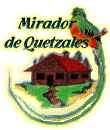







 The Quetzal (Pharomachrus mocinno) is the bird the Aztecs
adored, and it is considered one of the most beautiful birds in the tropics.
It is down here, in Mirador de Quetzales, where you can admire the
Quetzal at its best! Come and enjoy with us the warmth of our lodge,
sorrounded by Cloud Tropical Forest and clear water creeks flowing down
the mountains.
The Quetzal (Pharomachrus mocinno) is the bird the Aztecs
adored, and it is considered one of the most beautiful birds in the tropics.
It is down here, in Mirador de Quetzales, where you can admire the
Quetzal at its best! Come and enjoy with us the warmth of our lodge,
sorrounded by Cloud Tropical Forest and clear water creeks flowing down
the mountains. RESPLENDENT QUETZAL
((Pharomachrus mocinno)
RESPLENDENT QUETZAL
((Pharomachrus mocinno) Young: above dark sooty-brown; scapulars, wing-coverts, and tertials with extensive buffy bases and edges; below buff, fading to white on belly, indistinctly barred or smudged with dusky.
Habits: Prefers damp, epiphyte-laden mountain forests, frequenting canopy and edges, usually solitary or in pairs, though several may gather at a fruiting tree; may travel in small loose flocks following breeding; sallies to pluck fruits or snatch insects, small frogs and lizards or snails, favorite fruits include various Lauraceae, also Symplocos.
Voice: Most often heard is a sharp, cackling perwicka, upon taking flight or in agitation; male´s song of deep, smooth, slurret notes in simple patterns: keow kowee keow k´loo keow k´loo keeloo ..., often strikingly melodious; also whining notes, chiefly in nesting season; in steeply rising display flight, male calls very good, very good.
Nest: A deep, woodpeckerlike, unlined cavity with a single entrance, 14 - 90 ft (4.3 - 27 m) up in decaying trunk in forest or nearby clearing. Eggs 2, pale blue. March - June (often 2 broods).
Status: Fairly common resident of forested or partly forested mountains from Cordillera de Tilarán S to Panamá; upward from 4,000 ft (1,200 m) in Cordillera de Tilarán, and from 5,000 ft (1,500 m) to over 10,000 ft (3,000 m) in Cordilleras Central and of Talamanca; following breeding makes limited altitudinal movements; persists in largely deforested areas if remnant woods contain good feeding and nesting trees.
Range: Southern Mexico to Western Panamá. Note: Pronounced Ket-saal'
Young: above dark sooty-brown; scapulars, wing-coverts, and tertials with extensive buffy bases and edges; below buff, fading to white on belly, indistinctly barred or smudged with dusky.
Habits: Prefers damp, epiphyte-laden mountain forests, frequenting canopy and edges, usually solitary or in pairs, though several may gather at a fruiting tree; may travel in small loose flocks following breeding; sallies to pluck fruits or snatch insects, small frogs and lizards or snails, favorite fruits include various Lauraceae, also Symplocos.
Voice: Most often heard is a sharp, cackling perwicka, upon taking flight or in agitation; male´s song of deep, smooth, slurret notes in simple patterns: keow kowee keow k´loo keow k´loo keeloo ..., often strikingly melodious; also whining notes, chiefly in nesting season; in steeply rising display flight, male calls very good, very good.
Nest: A deep, woodpeckerlike, unlined cavity with a single entrance, 14 - 90 ft (4.3 - 27 m) up in decaying trunk in forest or nearby clearing. Eggs 2, pale blue. March - June (often 2 broods).
Status: Fairly common resident of forested or partly forested mountains from Cordillera de Tilarán S to Panamá; upward from 4,000 ft (1,200 m) in Cordillera de Tilarán, and from 5,000 ft (1,500 m) to over 10,000 ft (3,000 m) in Cordilleras Central and of Talamanca; following breeding makes limited altitudinal movements; persists in largely deforested areas if remnant woods contain good feeding and nesting trees.
Range: Southern Mexico to Western Panamá. Note: Pronounced Ket-saal'